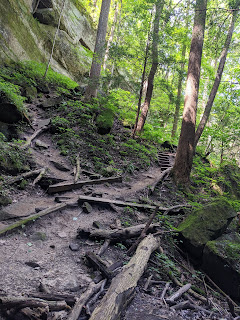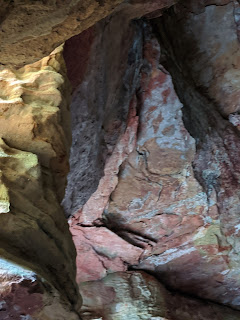As Steven and I drove along the back roads of southeastern Ohio and headed toward the state of West Virginia last August, we sure knew we were in the country when we spotted signs for Opossum Hollow Road, etc. This was definitely Trump country judging by all the yard signs, too.
I was more of an admirer of the unique quilt patterns on the sides of barns in the area as we drove along Highway 374, also known as the Ohio Byway.
Outside the town of Logan was Hocking Hills State Park, a 2,356-acre area that included huge cliffs, a river, waterfalls, and lots of trails.
Because of Covid-19, there was no park map or any description of any of the trails in the park. We sure hadn't done our due diligence to learn about the park and its trails in advance as we should have.
There was initially a pretty steep climb down the rocks to reach the Cantwell Cliffs, something I was not a huge fan of. I remember feeling at a distinct disadvantage wondering exactly what we'd gotten ourselves into and whether we might have overextended ourselves, or more to the point, my abilities.
Walking down the steps between the towering cliffs made us feel so minuscule.
Not much sun managed to enter the hemlock-shaded gorges.
As we hiked in the park, I was reminded of how small man is compared to the forces of nature.
I was so relieved getting back up to the higher ground and in one piece a while later! Also in the park, about a mile away, was a trail that led to Rock House, a set of caves where there was evidence showing Native Americans visited or lived during the 1700s. They called the river Hockhocking because of its gourd-shaped valley.
The profound effects of time, weather, and the historic Ice Age contributed to making the Hocking Hills region a unique and diverse place.
While it was illegal to carve into stone walls of the Rock House today, visitors of previous generations had thought it acceptable to leave their mark. We spotted carvings of names that dated back almost two hundred years. Mortars carved into the walls' recesses were also witness to the Indigenous people who had once used this 'house.'
This photo gives you a sense of how huge the cave or house was with Steven way off in the distance! It made perfect sense that, more recently, outlaws also used the caves as a hideout.
Steven and I had 'planned' or hoped to stop at three other areas that piqued our interest on the Ohio Byway but we realized the time had gotten away from us. We selected Cedar Falls from among Old Man's Cave and Ash Cave since we were determined to make it to Parkersburg, West Virginia, for a ride on a sternwheeler at 4 pm.
In terms of volume, Cedar Falls was the greatest waterfall in the Hocking Hills area although it appeared to be little more than a trickle on that August day. The stream flowing over the cliffs was named Queer Creek because of the stream's very odd northern backward flow.
There were trail markings at regular intervals on the trees in this section of the state park. It was sort of ironic, though, that they were largely unnecessary here because we simply had to follow the people in front of us as there was literally no other place to go!
In January of 1988, a once in every hundred years flood occurred, with the water ripping its way through the gorge, destroying and removing almost all the manmade structures. It did continue its never-ending work of carving the surrounding sandstone.
Even though it looked like a fun area to be in, because of the pandemic we deliberately opted to stay away from the crowds who had congregated under the cliffs.
We thought that by leaving the state park by 2:40, we'd certainly left enough time to drive east to the town of Athens and then on to Parkersburg in West Virginia to board the sternwheeler at 4. However, because of road construction, we were faced with an unanticipated 25-mile detour via Albany that meant we missed the last sternwheeler to Blennerhassett Island Historical State Park at 4 pm. That was a huge bummer as Steven and I love unusual boat trips and that would have been our first time on a sternwheeler.
There was no need for locals to go on a rollercoaster as all they had to do was drive their local roads which was pretty much the same thing!
Welcome to wild and wonderful West Virginia!
This was as close as we got to the old-time sternwheeler we'd wanted to take to the island - we arrived just as it was pulling away from the dock! Perhaps, if we're ever this way again, we'll make the ferry in time.
This stately home belonged to Peter Van Winkle who was born in New York in 1808 and moved to this West Virginia county a quarter-century later to practice law. He became a delegate to the Virginia constitutional convention in 1850 and was one of West Virginia's first US senators in 1863. Van Winkle was known for opposing the impeachment of President Andrew Johnson in 1868.
I noticed several of the mansions were for sale and all interestingly enough by Berkshire Hathaway, the company owned by Nebraska billionaire Warren Buffet.
































































No comments:
Post a Comment